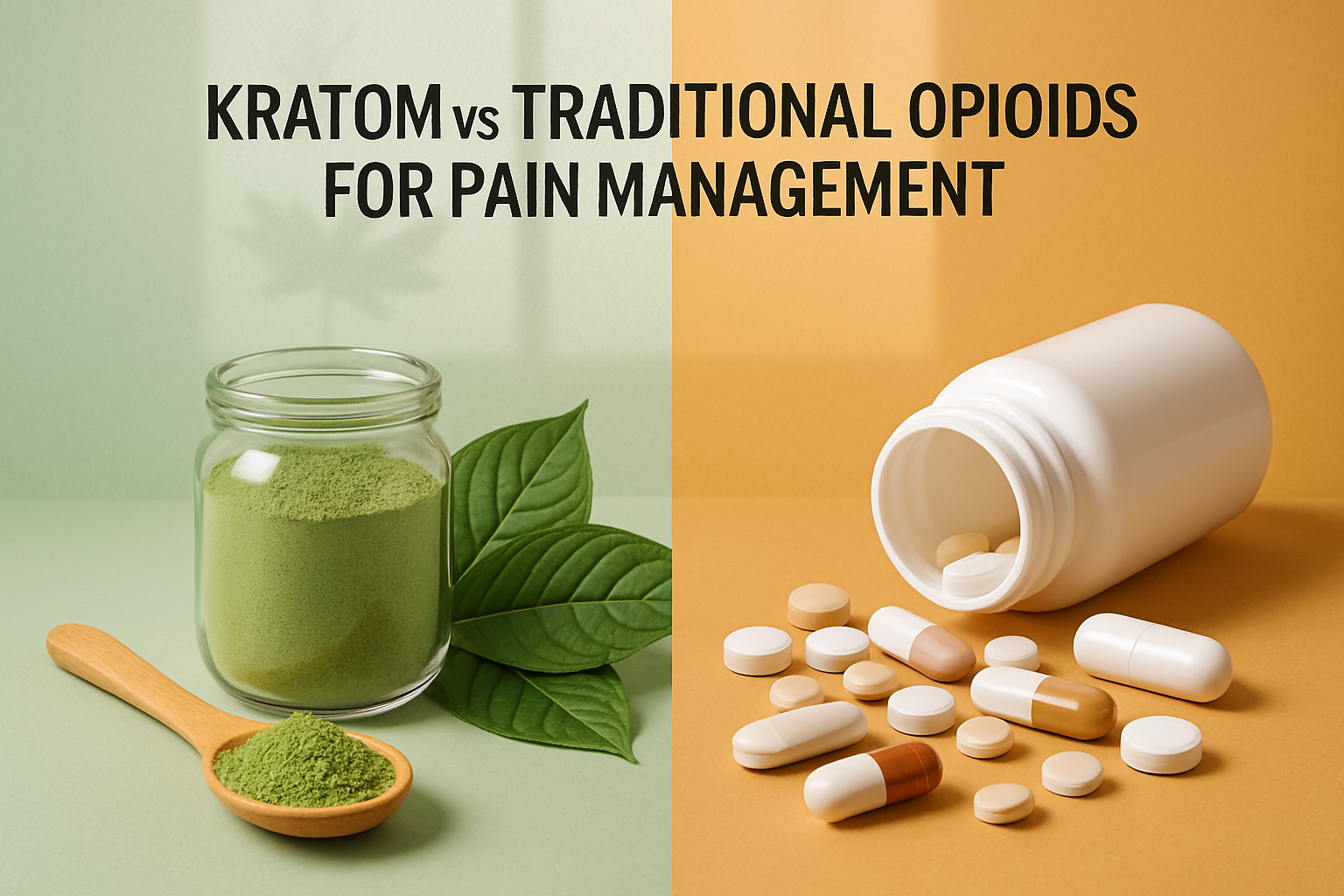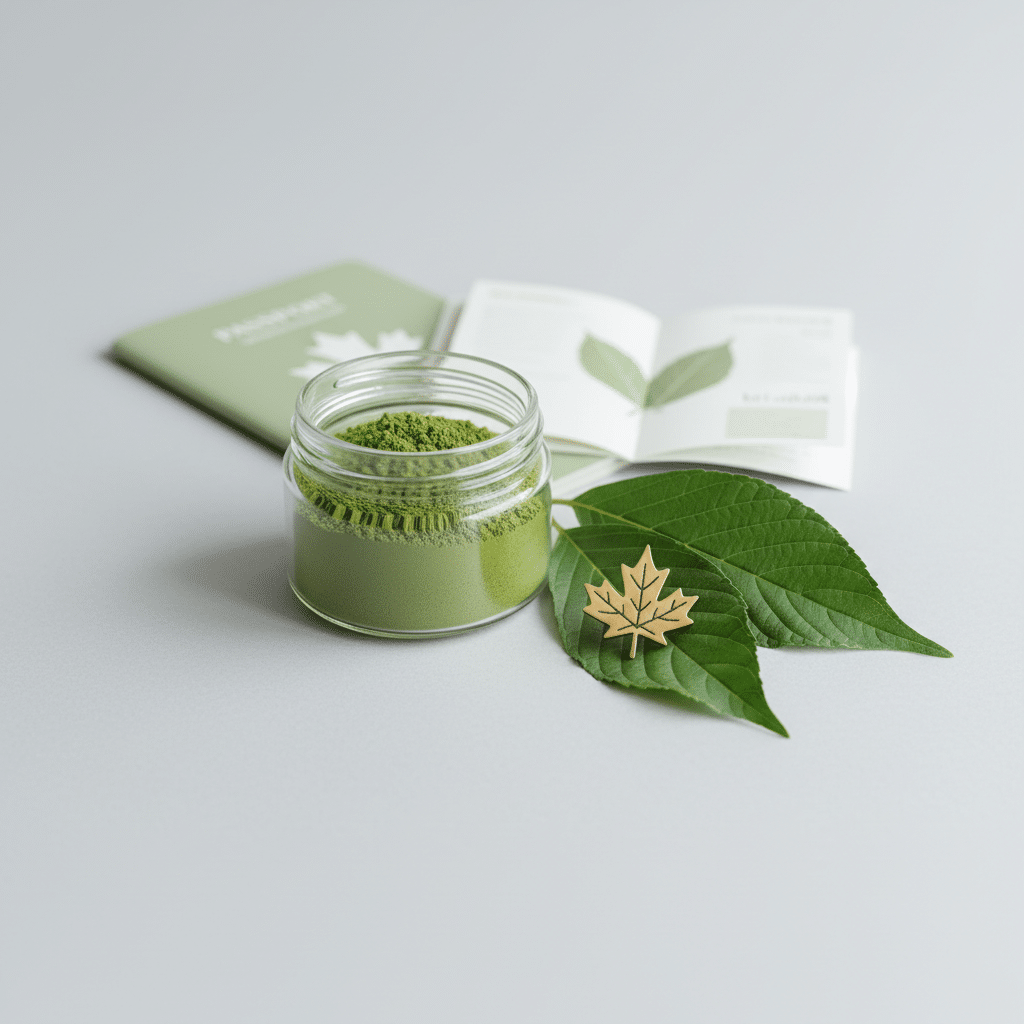
Over 70,000 Canadians died from opioid overdoses between 2016 and 2023, sparking urgent conversations about alternative pain management approaches. While traditional opioids carry significant risks of respiratory depression and dependency, botanical alternatives like kratom are gaining attention among researchers and individuals seeking natural pain relief options.
The comparison between kratom vs opioids reveals important distinctions in their mechanisms, safety profiles, and accessibility. Understanding these differences becomes crucial as more Canadians explore plant-based alternatives for managing chronic pain conditions.
Both substances interact with the body’s opioid receptor system, yet they produce markedly different effects and risk profiles. This analysis examines the current research, legal considerations, and practical implications for Canadians considering these options for pain management purposes.
Understanding Pain Relief: Kratom Compared to Opioids
The Science Behind Different Pain Management Approaches
Traditional opioids like morphine, fentanyl, and oxycodone work by binding to mu-opioid receptors in the brain and spinal cord. This interaction blocks pain signals while triggering the release of dopamine, creating both therapeutic effects and addiction potential.
Kratom contains over 40 alkaloids, with mitragynine and 7-hydroxymitragynine being the most studied compounds. Research shows that kratom’s mitragynine binds to mu-opioid receptors similarly to opioids, per FDA analysis from 2018. However, the binding affinity and downstream effects differ significantly from synthetic opioids.
The partial agonist activity of kratom alkaloids may explain why users report pain relief without the severe respiratory depression seen with traditional opioids. This pharmacological difference represents a key distinction in the kratom vs opioids comparison.
How Kratom Alkaloids Interact with Pain Receptors
Mitragynine acts as a partial agonist at mu-opioid receptors rather than a full agonist like morphine. This means it produces a “ceiling effect” – increasing the dose beyond a certain point doesn’t increase the effect proportionally.
The alkaloid also interacts with other receptor systems including alpha-2 adrenergic receptors and serotonin receptors. This multi-target approach may contribute to kratom’s reported effects on mood and energy levels alongside pain relief.
7-hydroxymitragynine, though present in smaller quantities, demonstrates higher potency at opioid receptors than mitragynine. The ratio of these alkaloids varies significantly between kratom strains and preparation methods, influencing the overall effect profile.
Effectiveness Research: Clinical Evidence for Pain Management
Published Studies on Kratom Pain Relief Properties
Recent research has begun quantifying kratom’s effects on pain perception in real-world settings. A 2025 study found that self-reported pain levels averaged 17.2 when kratom effects were felt versus 19.2 without recent use, suggesting measurable pain reduction benefits.
Cross-sectional surveys indicate that approximately 50% of kratom users report using it specifically for pain management. These individuals often describe switching from prescription opioids after finding kratom provided similar relief with fewer side effects.
However, controlled clinical trials remain limited due to regulatory restrictions. Most evidence comes from observational studies and user surveys rather than randomized controlled trials that would provide stronger scientific evidence.
|
Study Type |
Sample Size |
Pain Reduction Reported |
Limitations |
|---|---|---|---|
|
Cross-sectional survey |
8,049 users |
50% use for pain relief |
Self-reported data |
|
Longitudinal cohort |
2,798 users |
17.2 vs 19.2 pain scores |
Limited control group |
|
Case series |
161 patients |
45% reduced opioid use |
No placebo control |
Comparative Effectiveness for Chronic Pain Management
Traditional opioids demonstrate clear efficacy for acute pain management, with extensive clinical trial data supporting their use. Long-term effectiveness for chronic pain becomes more complex due to tolerance development and diminishing returns.
Natural pain relief alternatives like kratom may offer advantages for certain chronic conditions. Users frequently report sustained benefits without the escalating dosage requirements common with prescription opioids. This difference in tolerance patterns represents another important factor in kratom vs opioids comparisons.
The botanical nature of kratom means potency and alkaloid content can vary significantly between batches and suppliers. This variability makes dosing less predictable compared to standardized pharmaceutical opioids.
Safety Profile Analysis: Kratom vs Opioids Risk Assessment
Overdose Risk and Safety Margins
The most striking difference between kratom vs opioids lies in overdose mortality data. Between 2010 and 2016, 44 kratom-related deaths versus 217,000 opioid deaths were reported in the United States, highlighting dramatically different safety profiles.
Most kratom-associated fatalities involved multiple substances, making it difficult to establish kratom as the primary cause. In contrast, opioid overdoses frequently result from respiratory depression caused by the drug alone.
The ceiling effect of kratom’s partial agonist activity may prevent the severe respiratory depression that makes opioid overdoses fatal. However, this doesn’t eliminate all risks, particularly when kratom is combined with other central nervous system depressants.
Dependency and Tolerance Development Patterns
Physical dependence can develop with both kratom and opioids, but the patterns differ significantly. Research indicates that kratom doesn’t cause respiratory depression like opioids while showing potential for reducing opioid cravings in studies from 2019.
Withdrawal symptoms from kratom are generally reported as milder than opioid withdrawal, typically lasting 3-5 days versus weeks for prescription opioids. Users describe flu-like symptoms, mood changes, and sleep disturbances rather than the intense physical discomfort of opioid withdrawal.
Tolerance to kratom effects appears to develop more slowly than with traditional opioids. Many long-term users report maintaining stable doses for months or years, contrasting with the escalating requirements common in opioid tolerance.
Long-term Health Considerations
Limited long-term safety data exists for regular kratom use. Concerns include potential liver toxicity, though reports remain rare and often involve other substances or underlying conditions.
Traditional opioids carry well-documented risks including hormonal suppression, immune system effects, and hyperalgesia (increased pain sensitivity). The botanical compounds in kratom haven’t been associated with these specific long-term complications in available studies.
Quality and contamination represent significant concerns with kratom products. Unlike regulated pharmaceuticals, kratom lacks standardized manufacturing oversight, potentially exposing users to adulterants or inconsistent alkaloid content.
Legal Status and Accessibility in Canada
Current Canadian Regulations for Kratom Products
Kratom occupies a unique legal position in Canada compared to controlled opioids. Kratom remains unscheduled in Canada but lacks therapeutic approval according to 2021 regulatory patterns, meaning it can’t be marketed for medicinal purposes.
Health Canada permits kratom importation and sale for botanical, aromatic, and research purposes only. This regulatory framework allows access while acknowledging the lack of approved therapeutic applications.
Prescription opioids require medical authorization and are subject to strict dispensing controls. This regulatory difference affects how Canadians can access these different pain management options.
Quality Assurance and Testing Requirements
Canadian kratom suppliers operate without mandatory testing requirements, unlike pharmaceutical manufacturers. Reputable vendors voluntarily conduct laboratory testing for purity, potency, and contaminants.
Companies like 365 Kratom Canada have implemented comprehensive testing protocols, analyzing each batch for alkaloid content, heavy metals, pesticides, and microbial contamination. This voluntary quality assurance helps address safety concerns in an unregulated market.
Prescription opioids must meet rigorous manufacturing standards including Good Manufacturing Practices (GMP) and regular facility inspections. This regulatory oversight ensures consistent quality and safety in pharmaceutical products.
Practical Considerations for Canadian Users
Harm Reduction Approaches
Individuals considering botanical opioid alternatives should prioritize safety and quality sourcing. Research suppliers’ testing practices, start with minimal amounts, and avoid combining substances.
Healthcare provider consultation remains important regardless of legal status. Many physicians are becoming more informed about kratom use and can provide guidance on potential interactions with existing medications.
Pain management kratom vs opioids decisions should consider individual health conditions, response patterns, and treatment goals. What works for one person may not be appropriate for another.
Dosage and Administration Considerations
Kratom dosing differs significantly from standardized pharmaceutical preparations. Effects can vary based on strain, preparation method, individual tolerance, and stomach contents.
Starting doses typically range from 1-2 grams, with users gradually adjusting based on effects and tolerance. This contrasts with precise pharmaceutical dosing protocols for prescription opioids.
The delayed onset of kratom effects (30-45 minutes) can lead to inadvertent overdosing if users take additional amounts too quickly. Patience and careful dose escalation help minimize this risk.
Ready to explore quality kratom options? Check out 365 Kratom Canada’s Relax blend for carefully crafted, lab-tested kratom products designed for Canadian researchers and botanical enthusiasts.
Frequently Asked Questions
Is kratom safer than prescription opioids for pain management?
Available data suggests kratom has a significantly lower overdose risk compared to traditional opioids. The 44 kratom-related deaths versus 217,000 opioid deaths between 2010-2016 indicates a substantial safety difference. However, kratom isn’t risk-free, and quality varies significantly between suppliers.
Can kratom help with opioid withdrawal symptoms?
Some users report kratom helps manage opioid withdrawal discomfort, though clinical evidence remains limited. The alkaloids’ interaction with opioid receptors may reduce cravings and ease transition symptoms. Anyone considering this approach should consult healthcare providers for proper medical supervision.
What’s the legal status of kratom vs opioids in Canada?
Kratom remains unscheduled in Canada but can only be sold for botanical, aromatic, and research purposes – not as medicine. Prescription opioids require medical authorization and pharmacy dispensing. This difference affects legal access methods for Canadian consumers.
How do I choose quality kratom products in Canada?
Look for suppliers who provide laboratory testing certificates for each batch, testing for alkaloid content, contaminants, and purity. Reputable vendors voluntarily implement quality controls similar to pharmaceutical standards, even though regulations don’t require it.
What dosage should beginners start with for kratom?
New users should start with 1-2 grams and wait 45-60 minutes before taking more. Kratom’s delayed onset can lead to taking too much if you’re impatient. Gradually increase by 0.5-1 gram increments until finding your optimal dose.
Moving Forward: Informed Choices in Pain Management
The comparison between kratom vs opioids reveals important differences in safety profiles, legal accessibility, and pharmacological mechanisms. While traditional opioids carry well-documented risks including respiratory depression and severe dependency potential, kratom presents an alternative with different risk-benefit considerations.
Current research suggests kratom may offer pain relief benefits with lower overdose risks compared to prescription opioids. However, the lack of standardized regulations means quality assurance depends entirely on supplier practices and voluntary testing protocols.
Canadian users exploring natural pain relief alternatives should prioritize education, quality sourcing, and healthcare consultation. The botanical nature of kratom requires careful attention to dosing, supplier selection, and individual response patterns.
For those interested in exploring lab-tested kratom options, 365 Kratom Canada’s collection offers carefully crafted blends designed for Canadian researchers seeking consistent, quality-assured botanical products.


